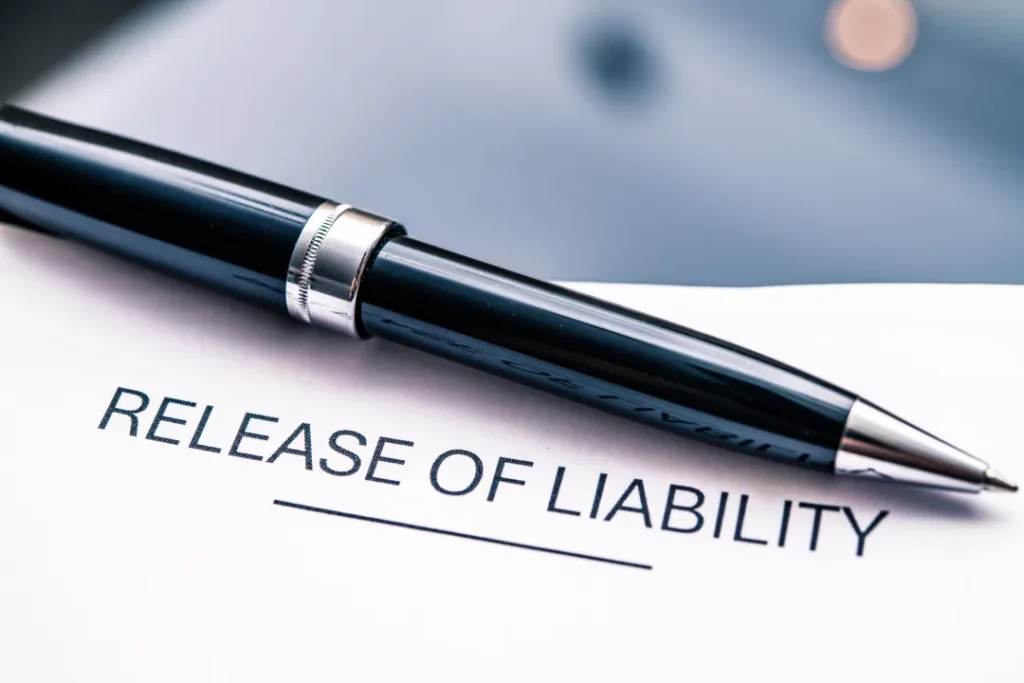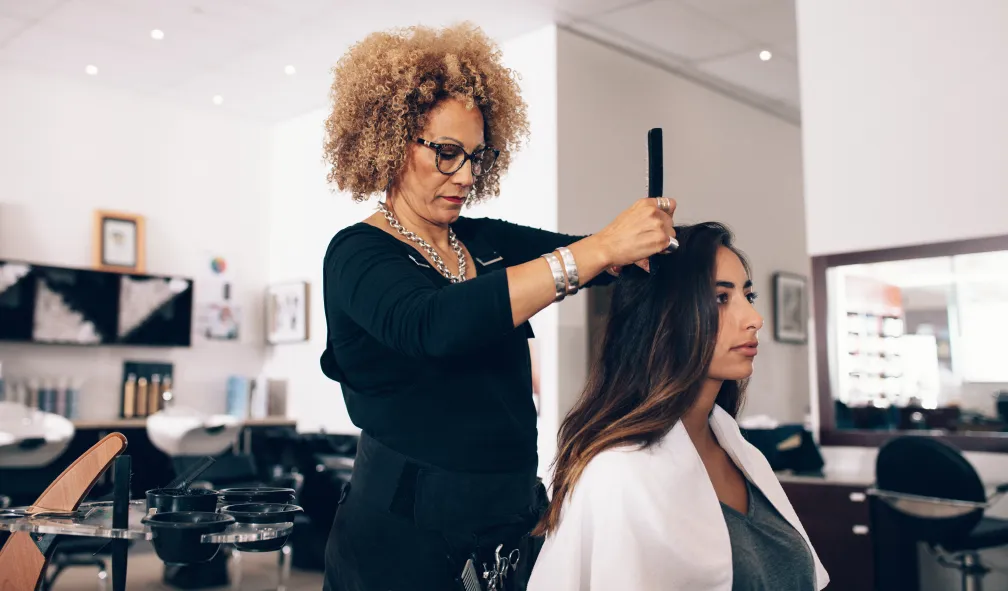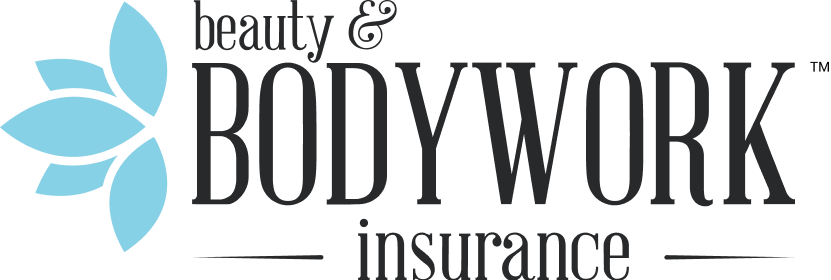A liability waiver for salons is a short form that clients sign before receiving services. It documents that they understand the potential risks and agree not to sue you if something goes wrong.
This blog gives you the basics on liability waivers. Talk to a lawyer for guidance specific to your salon!
What Is a Salon Waiver Form? (+ Why They are Essential)
A salon waiver form is a written agreement where clients acknowledge service-related risks and release your salon from certain liabilities.
Essentially, it’s a document that says, “I understand I might experience a reaction to a product, for example, but I won’t take legal action against your salon if that happens.”
What’s in it for you: You don’t want to be held legally responsible for accidents at your salon, so you implement a waiver form.
What’s in it for clients: They want to make an informed decision and choose to go through with your services, knowing the risk involved.
Think of it as a tradeoff between you and your clients — one that supports transparency and guides both parties toward the ultimate goal: beautiful hair, nails, etc.!
Bottom line? A salon liability waiver is the go-ahead for clients to take a seat in your chair.

From an Expert: Should I Use a Salon Waiver Form to Help Limit My Liability?
“Absolutely. We always recommend liability waivers — a legal document, so have it looked over by a professional. Waivers don’t stop someone from suing you, but they definitely help limit your liability or limit those claims from coming in.
For example, a situation where a client says they’re not allergic to XYZ ingredients. ‘I used them. You had a reaction.’ A waiver can help mitigate these risks.” – JoAnne Hammer, Beauty & Bodywork Insurance (BBI) Program Manager (Webinar: Building a Resilient Business)
Pro Tip: If you’re formalizing waivers, it’s also smart to review liability coverage options — here’s more information about salon insurance.
Why Salon Liability Waivers Are Important
Educates Your Clients
From harsh chemicals to hidden allergies, beauty services carry inherent risks. Clients must understand possible outcomes — aside from getting a gorgeous new look. A waiver makes them more aware that there’s a chance things may go unexpectedly.
Protects Your Salon
A waiver sets clear expectations and reduces your salon’s legal risk by allowing clients to take on the liability themselves. It’s a condition for receiving services. Like a cape draped over your entire salon, it helps protect your business from messy lawsuits.
Boosts Credibility
This simple form signals your professionalism and shows that you run a responsible business. Because you take the steps to outline risks, present them to your clients beforehand, and keep everyone on the same page, you boost client confidence.
Pro Tip: Waivers are one piece of the salon management puzzle. Check out our Top Tips for Running a Successful Beauty Salon for more can’t-miss ideas.
What to Include on a Liability Waiver
A salon liability waiver only protects your business in the context of what’s written into it. These are the essential elements to include on your waiver.
- Salon details: The who and what of your salon, including your DBA (doing business as) name, contact information, and state license numbers
- Acknowledgment of risk: The client says they understand the risks involved with your salon’s beauty services (listed out, but “not limited to”)
- Consent to treatment: They agree to receive the treatments your salon offers (also listed out, but “not limited to”)
- Release of liability: They release your salon from any legal responsibility for damages arising from your services (with exceptions, like gross negligence)
- Medical disclosure: They confirm they’ve disclosed known medical conditions or allergies that may affect the services they receive
- Photo/media consent: Optional — they allow your salon to use their photos or videos for marketing purposes
- Signature and date: They sign their name to get it all officially in writing
Here are some key details to keep in mind:
- You can’t write out every possible risk in your waiver. That’s why it’s crucial to have a lawyer review your language to ensure it covers your salon as comprehensively as possible.
- A waiver cannot magically cover everything. For example, if one of your stylists is intentionally negligent or if you’ve included an unenforceable clause, your waiver won’t protect your salon.
- Use plain language. Make it as easy as possible for clients to understand what they’re signing, because vague or overly complex jargon can be ruled invalid by a court.
- Laws vary by state, so speak to a lawyer who understands your local rules before implementing your waiver.
Pro Tip: Don’t say, “incidental risks including but not limited to dermatological reactions, adverse outcomes, or unforeseen bodily injury.” Say, “may cause skin irritation, allergic reactions, or other side effects.”

How to Use a Salon Client Liability Waiver Template
Start using a salon liability waiver form before your next booking. Here’s how.
- Download a template, like this one from Jotform
- Customize the template to your business
– Add your salon branding
– Tailor the waiver to specific services you offer
– Outline possible risks clients may experience
– Include any state or local legal requirements
– Adjust other sections as needed - Get legal guidance on your waiver form to ensure it’s compliant and is written in the strongest, clearest way possible to protect your salon from potential liabilities
- Present it to first-time clients so they can acknowledge and sign it
- Store forms securely in case of disputes or questions later on
- Train staff to explain it in friendly, transparent language
- Update your form every year or whenever services change

Protect Your Salon With Liability Insurance
A salon liability waiver is a great first step, but it’s not enough to fully protect your business from dreaded lawsuits. That’s where salon insurance comes in, catching any stray accidents, professional mistakes, or unmet expectations that fall through the cracks of your waiver.
Salon insurance is a financial safety net against common salon owner claims you face, like slip-and-falls or service-related injuries. It steps in to pay for liability claims, so you don’t have to shoulder the costs on your own.
BBI offers top-rated salon coverage with a unique per-station model. Cover each station or booth with a single policy, along with every stylist who works them. Pricing starts at $31.08/month, with optional add-ons for tools and supplies, and more.
Your salon waiver and liability insurance work together, like a thorough consultation and a patch test, shielding your business from life’s unexpected moments.
FAQs About Salon Waivers
Can I Customize a Salon Waiver Template?
Yes, you can customize a salon waiver template. Many online form builder tools allow for easy personalization to ensure you add any necessary sections relevant to your salon. Always have a legal professional review your form before use.
Is a Liability Waiver Legally Binding in My State?
It depends on your state laws. Many courts will accept waivers if they’re clear, fair, and not overly one-sided, but rules vary. That’s why it’s important to have a local attorney review your form before you implement it at your salon.
How Do I Handle Clients Who Refuse to Sign a Liability Waiver?
If a client won’t sign, you’re free not to provide the service. It may feel uncomfortable to refuse service, but protecting your business from potential legal risk outweighs losing a single appointment.
But, if your client is willing to have a conversation about it, frame the waiver as your salon’s way of being transparent and safe for everyone.
Along With a Waiver, What Kind of Insurance Do I Need?
Along with a liability waiver, you need general and professional liability insurance to protect against third-party injuries, property damage, and service-related accidents.
Learn more about recommended salon insurance types (with an easy coverage selector).

JoAnne Hammer | Program Manager
JoAnne Hammer is the Program Manager for Beauty and Bodywork Insurance. She has held the prestigious Certified Insurance Counselor (CIC) designation since July 2004.
JoAnne understands that starting and operating a business takes a tremendous amount of time, dedication, and financial resources. She believes that insurance is the single best way to protect your investment, business, and personal assets.
JoAnne Hammer is the Program Manager for Beauty and Bodywork Insurance. She has held the prestigious Certified Insurance Counselor (CIC) designation since July 2004.
JoAnne understands that starting and operating a business takes a tremendous amount of time, dedication, and financial resources. She believes that insurance is the single best way to protect your investment, business, and personal assets.





